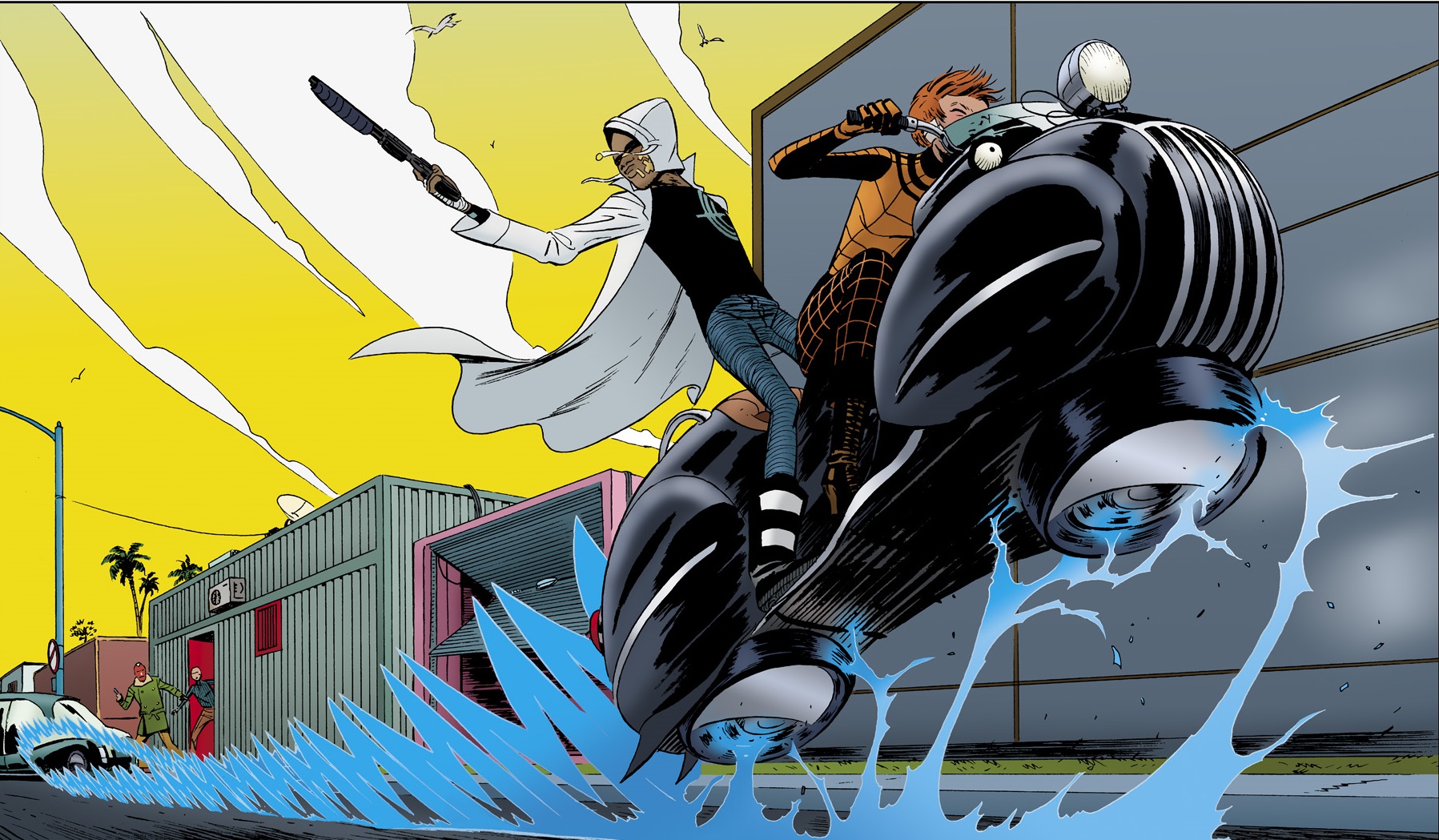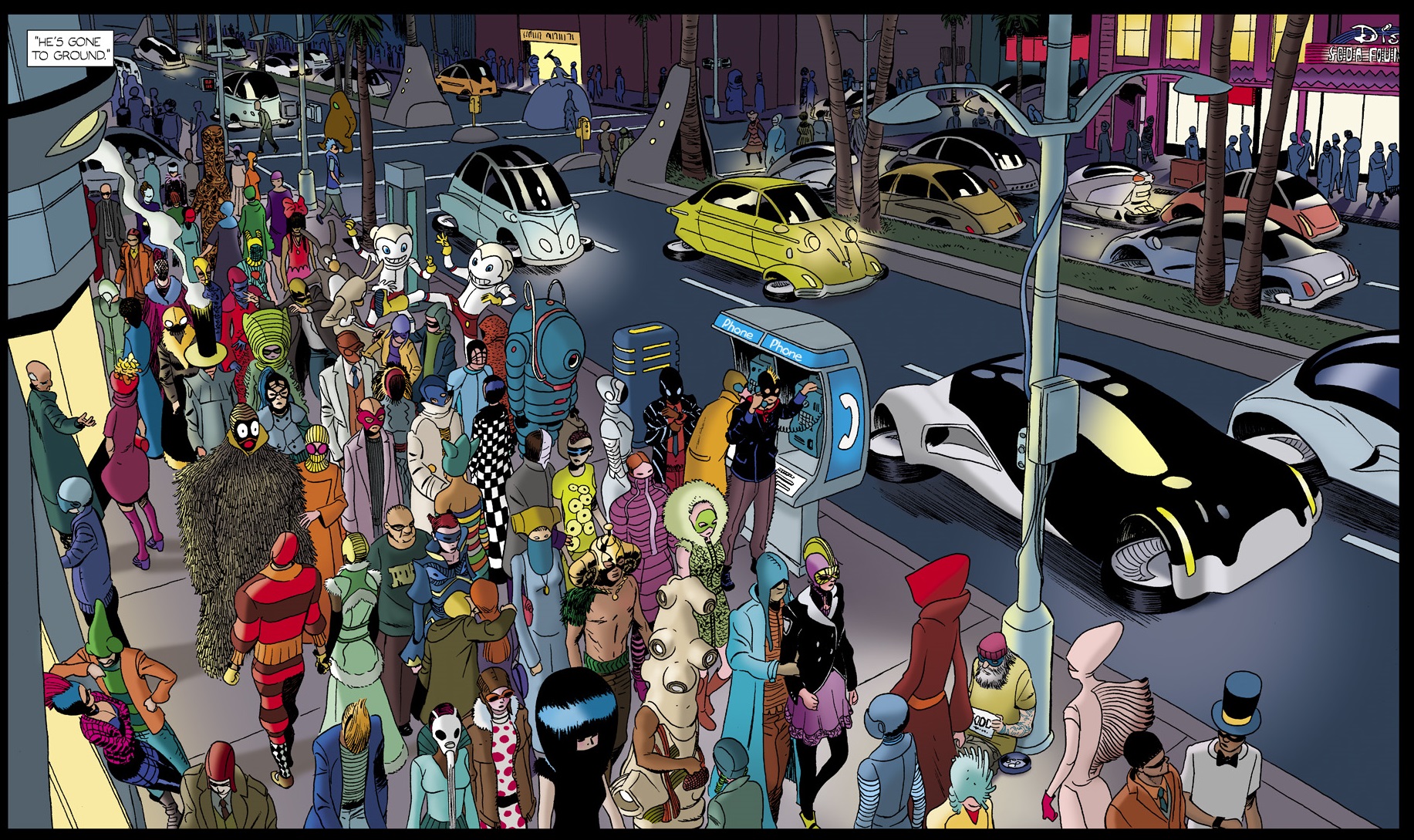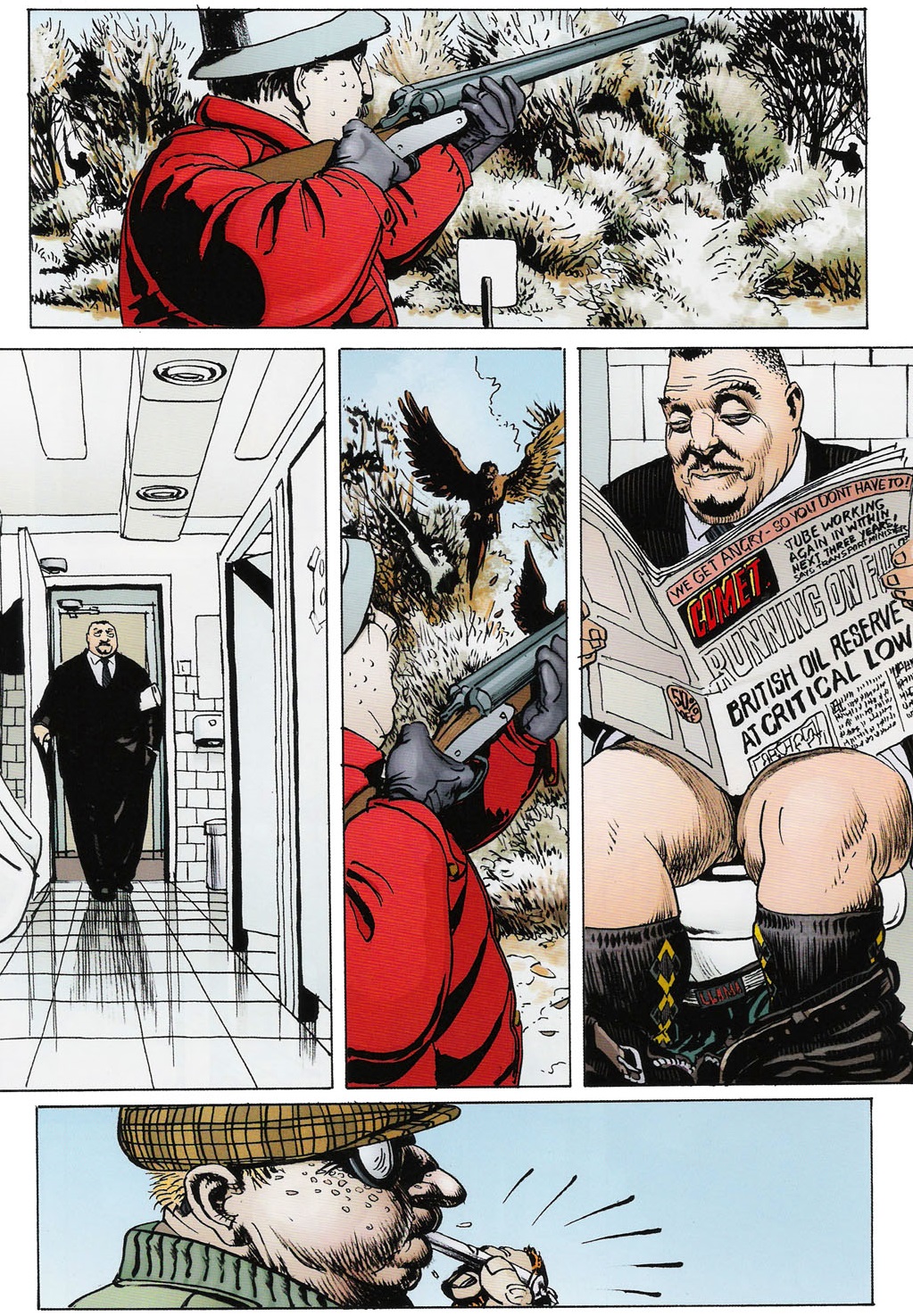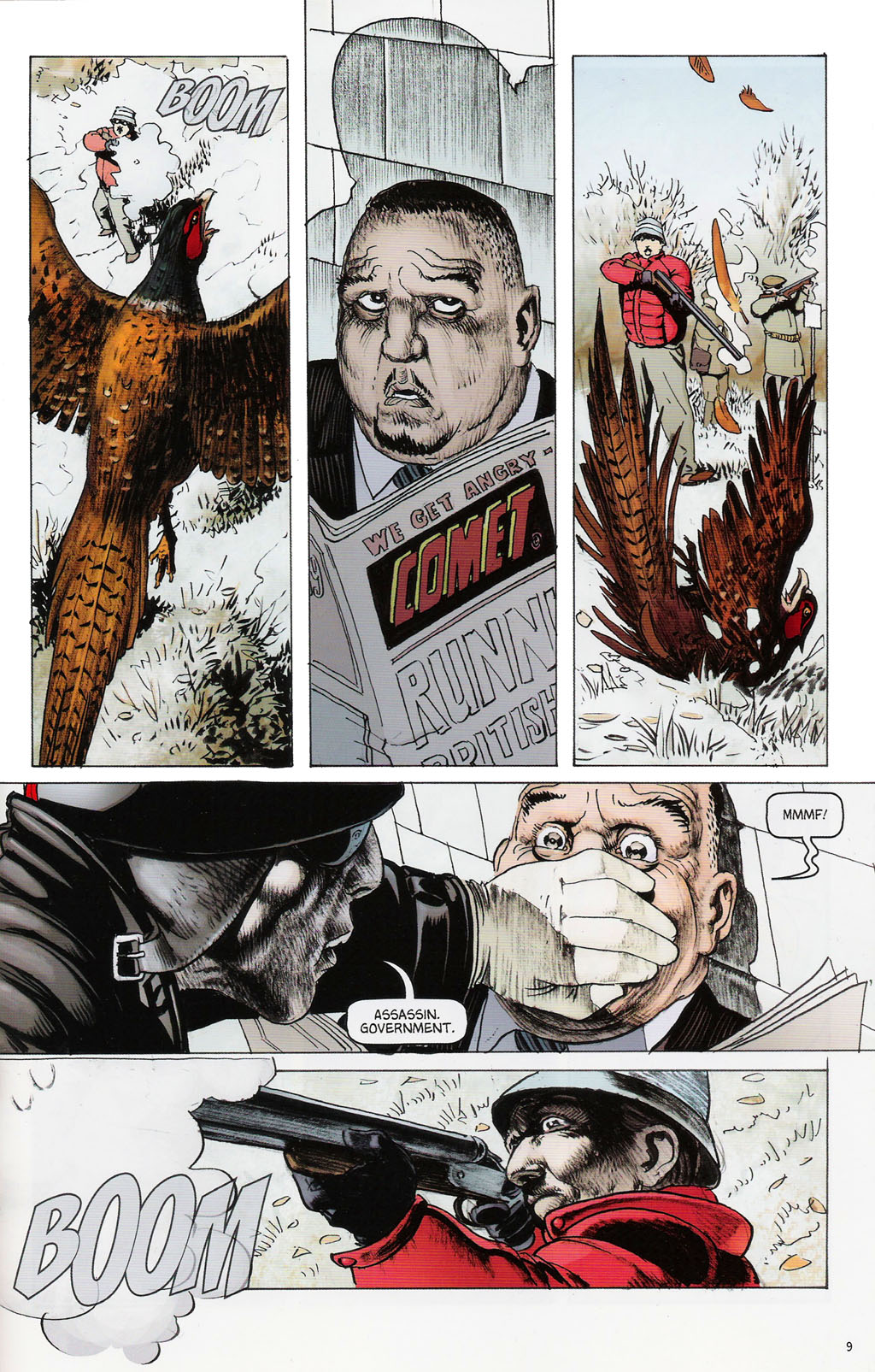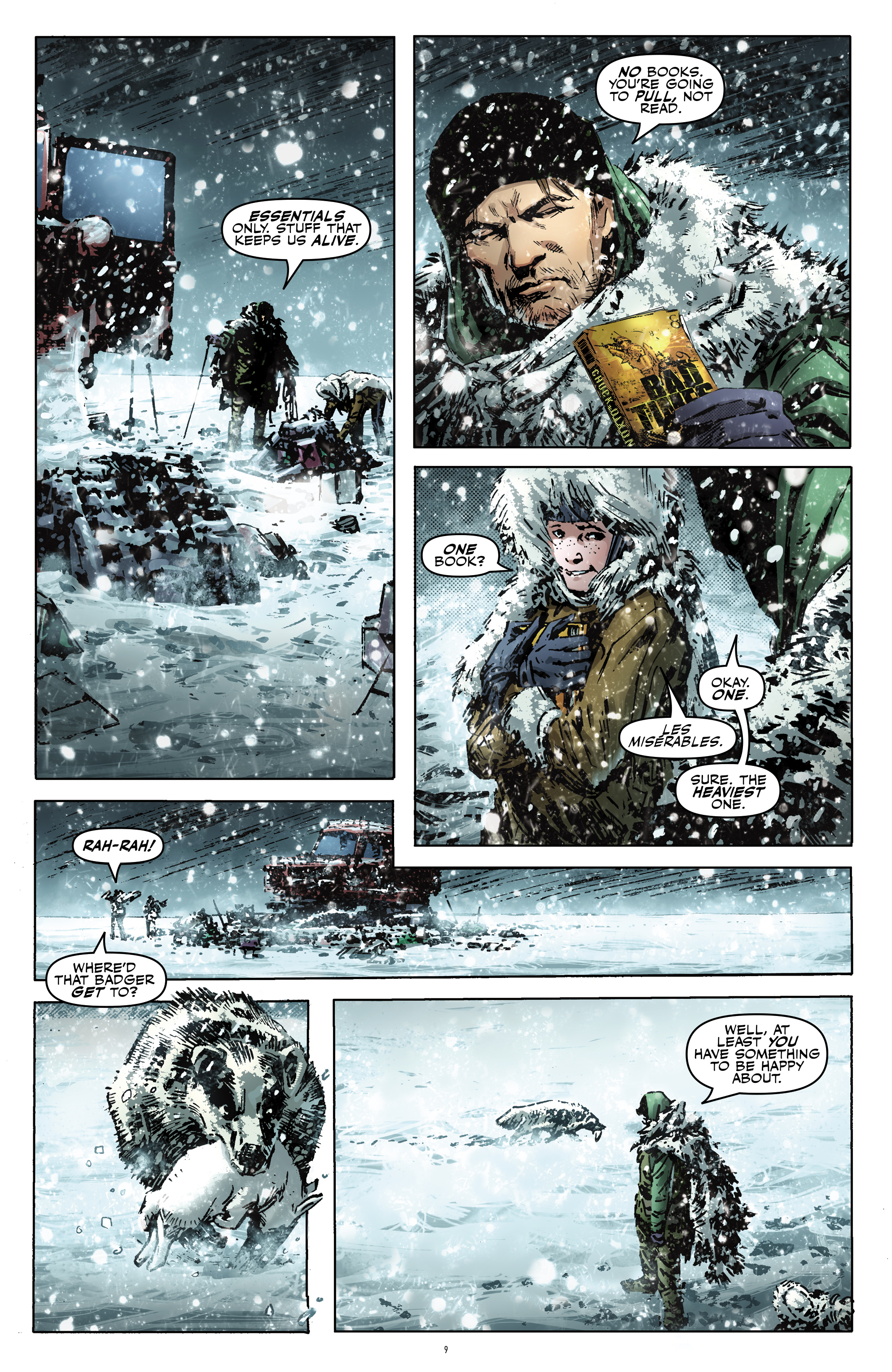After a week binging the growing subgenre of paranoia-inducing documentaries about paranoia-inducing social media (The Social Dilemma, Agents of Chaos, The Great Hack), a lot of science fiction has come to feel positively *quaint* in comparison with the current times… Still, if you read last week’s post, you know what’s going on. Here is another trio of comics whose visions of the future haven’t exactly come to be (so far) and which therefore remain exciting, imaginative reads:
THE PRIVATE EYE
After the Cloud burst and exposed everyone’s sordid secrets, the internet was banned and society became obsessed with privacy. In this 10-issue series (which, ironically, made its debut exclusively online, back in 2013), the dream creative team of Brian K. Vaughan and Marcos Martin tapped into the zeitgeist by imagining rupture rather than continuity: The Private Eye’s future is post-virtual and post-surveillance, with practically everyone hiding behind at least one secret identity. Avatars are no longer an online thing, but a common practice in your everyday life (the fact that most people now wear masks in public is the one striking similarity with our 2020, although the masks in the comic are way cooler!). At the same time, the line between investigative journalism and law enforcement has become blurrier than ever…
The plot is a noir mystery that leads into a conspiracy thriller – a proven formula for exploring this kind of sci-fi worlds, perfected by the likes of Soylent Green and Minority Report (among countless others).
As you can see in the splash above, Marcos Martin and colorist Muntsa Vicente create a futuristic Los Angeles with plenty of zany disguises and an architecture that reflects a new approach towards materiality. The idea is that, without the internet, we would turn with renewed interest into the physical world, bringing back objects like phone booths and pneumatic tubes. The ensuing vistas and action scenes have a pretty spectacular feel thanks to the comic’s horizontal format (later converted into a keen hardcover, published by Image), which flows quite well with Brian K. Vaughan’s typically clippy pace.
SMOKE
Alex de Campi’s and Igor Kordey’s 2005 mini-series Smoke imagined the then-near future of 2012 through the lens of early 21st century British anxieties, many of which remain topical today. Having gone bankrupt, the UK government finds itself dealing with both an oil shortage and a sinister cabal pulling the strings in the background. Things haven’t turned out that way in our reality, but for the most part you get the impression that they could’ve, except for a couple of low-key sci-fi elements and occasional bursts of all-out satire (including a group of obese terrorists who identify themselves as the Right to Beauty Brigade). Above all, the comic has a contagious punk attitude, from Kordey’s awesome, Banksy-esque covers to the killer lines in the radio broadcast/Greek chorus that opens and closes each issue (‘This has been Radio Seven reporting from London, the Big Smoke, the city that’ll borrow everything you have, and won’t pay you back…’).
By itself, all this would be enough to make Smoke a fun, interesting read, but the main reason to revisit this series is that it’s also one kickass thrill ride, with an intricate narrative that mixes espionage with political intrigue and human drama, told in a fast-pasted, maximalist style. Kordey’s art sharply conveys all sorts of peripheral information while nailing both the cast’s characterization and de Campi’s rich world-building. He also throws himself into utterly exhilarating action set pieces, including adrenaline-charged shootouts (the second issue opens with a masterclass of this type of scene) and rhythmic montages like this one:
Igor Kordey’s virtuoso storytelling is sadly missing from Smoke’s sequel, Ashes, originally serialized online and eventually collected, together with the original mini-series, in a thick volume from 2013. If the former series had an elaborate narrative delivered through crisp visuals, the follow-up goes in the opposite direction.
Not that Ashes’ artists are bad – Milton, Felipe Sobreiro, and Mack Chater, who draw much of it, do a fine job, even if they don’t match Kordey’s flair for composition. Dan McDaid and Colleen Doran have an even more strikingly different sense of design, yet they come closer to capturing Smoke’s phenomenal dynamism. In turn, Richard Pace’s scratchy contributions are neither here nor there, completely taking me out of this world… Indeed, the fact that you get so many creators with distinctive styles (Bill Sienkiewicz, Alice Duke, Alem Curin, Jesse Hamm, and R.M Guéra join the party as well) generates quite a disorienting object: the protagonists’ looks change so much from chapter to chapter – and even within some chapters – that it becomes hard to accept them as coherent characters, which undermines some of the tale’s heart. That said, the aesthetic experimentation is also there by design, as Alex de Campi keeps writing brief sequences in different genres, from film pastiches to children’s storybooks and medieval literature, so while the result may be a bit of a mess, at least it’s ambitious and never visually boring.
The biggest letdown is the story itself. De Campi, who has proven to be a highly skilled plotter both in Smoke and in later projects (including another spy extravaganza, Mayday), here settles for a clichéd scenario about a couple on the run from a vengeful virtual killer who is able to follow them through the internet, plus some nanotech bullshit. Ashes squeezes a healthy dose of paranoia out of the notion of hyper-surveillance in the information age, but plotwise (and even thematically) it feels quite thin, without the sprawling twists and turns that make Smoke such a blast.
I like the detour about the genetically engineered meat industry, though!
WINTERWORLD
Set in a future where the world has become stuck in a state of perpetual winter, this is an effective variation on the post-apocalyptic survivalist adventure, complete with a rugged protagonist (who befriends a spunky young girl and a badger), gun-toting tribes of slavers, and odd cults built around misremembered remnants of the past (‘They think Pizza Hut was the name of a great man who lived before the time the Earth was frozen.’). Chuck Dixon is the right writer for this type of material, given his knack for terse dialogue and taut action. As usual, while Dixon’s plots won’t blow your mind with originality, at least they excel at nailing each genre beat with immaculate precision and blunt impact.
Winterworld started out as a mini-series published by Eclipse back in 1987, clearly (yet ingeniously) riding the popularity of the Mad Max sequels… Although it’s never explicitly stated, I’m guessing the implication was that in this version of the future the Cold War had led to an atomic conflict and the story took place during the ensuing nuclear winter. The original artist was Jorge Zaffino, who drenched the whole thing in the kind of gritty crosshatching and stark light/shadow contrasts suited for such a violent yarn about desperate people fighting in the ruins of civilization. I also like Julie Michel’s dry colors, unfortunately absent from IDW’s 2011 collected edition, even if Zaffino’s rough, uncolored art has its own appeal (curiously, the choice to republish the comic in black & white ended up evoking Greg Rucka’s and Steve Lieber’s own snowbound indie thriller, Whiteout). That collection also includes the comic’s never-before-published sequel, WinterSea.
In 2014, Chuck Dixon picked up where he left off through a new Winterworld series, which told the further adventures of the original ragtag trio of snow wanderers, kicking things off with majestic visuals by Butch Guice, colored by Diego Rodriguez. As with many of Dixon’s later-day comics, there is a more pronounced satirical edge, albeit one that never quite undermines the overall tension, as he continues to seem more interested in the thrilling narrative possibilities of ecological and social collapse than in any serious moral lesson beyond a degree of anthropological pessimism (if you’re wondering how Dixon copes with the setting’s obvious association to climate change now that this has become a sort of taboo for his political camp, the answer takes the form of some genuinely amusing dark comedy).
Additionally, Dixon wrote a vicious prose novel, The Mechanic’s Song, in which one of Winterworld’s protagonists reminisces about his younger years in this dangerous frozen wasteland. Like with the Bad Times books (briefly glimpsed in the page above), this one seems driven by a gleeful mischievousness. There are even a couple of playful metafictional moments, like the revelation, early on, that the person who transcribed the narrator’s words added her own flourishes to the opening chapter – a revelation that channels Dixon’s typical mistrust of pretentious, highbrow literature, proudly positioning the following text closer to Spillane than to Flaubert (and yes, you may read in this an unsubtle affirmation of American popular culture against European elitism). That said, it’s still a bleak, brutal read, made even harsher by the fact that the prose is surprisingly light on dialogue despite being penned by a comic book writer. The influence from Cormac McCarthy’s The Road is pretty blatant, although Dixon certainly feels right at home delivering hard-hitting passages in a gripping staccato:
“The old man had a rifle. An old bolt action job worn down to the bare metal. He kept that sucker oiled and clean. Took better care of it than he did his own woman and kids. It had a cracked wooden stock he bound with tape and wire. When he took it up on the ice it was wrapped in a woolen skin to keep the cold out of the metal. The old man told me that the metal of the barrel would crack from the sudden heat of the bullet if he let the steel get too cold. He told me we had to keep the rifle clean and warm. That was the only thing worth a damn he ever taught me.”

